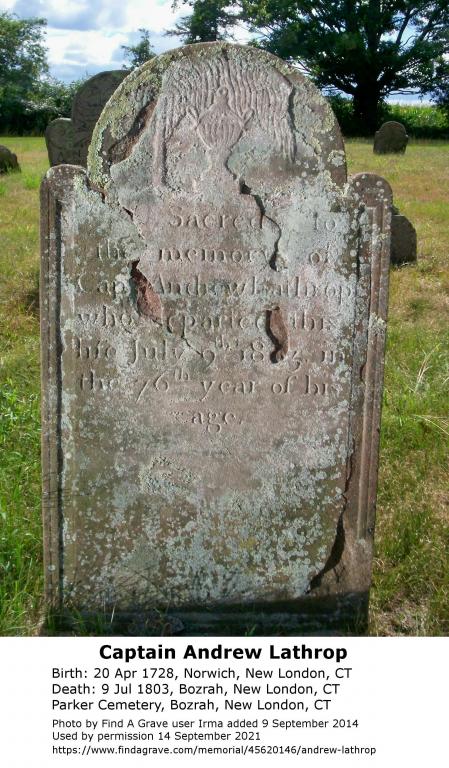Author: Robert Clyde Eager
Andrew Lathrop’s ancestors were some of the earliest settlers in New England. In 1632, Rev. John Lathrop, a graduate of Queens College, Cambridge, was seized and sent to Newgate prison for his religious practices. Later released, he, and his nine-year-old son, Samuel, were among the 200 passengers aboard the Griffith and another ship that arrived on Cape Cod in 1634. Years later, in 1668, at the age of 43, Samuel would move From Barnstable, MA, where the Lathrops were well established, to Norwich, CT, and become one of the founding members of that community.
By 1728, Samuel’s descendants were numerous and prominent in Norwich and the surrounding area. It was there on September 28 that a great-grandson, Andrew Lathrop, was born. He was the fifth in a family of eight sons born to William Lathrop and Sarah Huntington. The Huntingtons were also an old and prominent family. Sarah’s second cousin, Samuel Huntington, would later sign the Declaration of Independence and serve as President of the Continental Congress from 1779 to 1781.
Andrew married Deborah Woodworth on October 15, 1755. Their son, Jesse, was born in June of 1760. The records don’t indicate the causes of death, but Deborah died in October, just four months later. Then, in January the following year, Jesse died at age six months.
Andrew married again, three years later, on September 14, 1763. He and Abigail Fish settled in neighboring Bozrah, CT. They would eventually have seven children, only one of whom died in infancy. Circumstances in the fall of 1776 would find him, at age 48, with a family of five young children under the age of twelve. It was then that he was called upon to go to war.
Andrew had risen to the rank of Captain and commanded a cavalry company in support of a local militia unit. In June of 1776, seven such companies were reorganized under the command of Major Ebenezer Backus as the 4th Connecticut Regiment of Light Horse. In September, they were assigned for temporary service in the Continental Army.
Washington had recently suffered a disastrous defeat at the Battle of Long Island. He evacuated New York City and began a long retreat across New York and New Jersey with the British in hot pursuit. In October, Washington decided to make a stand, positioning his forces on the hills around White Plains in Westchester County, NY. This was where the Connecticut 4th Regiment was called into service.
The role of a light horse company was to serve as a vedette. It was daring and dangerous duty, as they would roam in front of the lines, in advance of the pickets, probing and searching out enemy locations so that the main army would not be caught by surprise.
The Battle of White Plains initially viewed as a defeat, would later be recognized for Washington’s ability to prevent envelopment by General Howe’s superior forces. He was able to withdraw his troops in good order and preserve the army so that several months later, in December of that year, he could cross the Delaware River and deliver surprise blows at Trenton and Princeton.
In November, a relief force had arrived, Washington dismissed the 4th Connecticut, “with the General’s hearty thanks for their faithful services, and the cheerfulness and alacrity they have shown up on all occasions.” It is likely that Captain Lathrop’s militia service continued after that. The War Department records only reflect that period of three months when the 4th Regiment was attached to Washington’s Continental Army.
March of 1778 would see the birth of Andrew’s last child, another daughter. After being raised in a houseful of boys himself, he and Abigail would only have one son. As his family grew to adulthood, Captain Lathrop accumulated real estate and personal property, and in 1795 wrote his last will and testament. He named his son, Andrew Jr., as his sole executor. To his wife and children, he left seven parcels of land totaling around 130 acres. A later inventory would estimate the value of real and personal property at $3,661.
Captain Andrew Lathrop died on July 9, 1803, and was laid to rest in the Parker Cemetery in Bozrah. His wife, Abigail, would survive him by almost nine years, passing on Jan. 12, 1812.
--Submitted by descendant Robert Eager NSSAR# 179422.
Sources and References
Borkow, Richard. "Westchester County, New York, and the Revolutionary War: The Battle of White Plains (1776)", Westchester Magazine, June 14, 2013, https://westchestermagazine.com/uncategorized/westchester-county-new-york-and-the-revolutionary-war-the-battle-of-white-plains-1776/
Connecticut, U.S., Wills and Probate Records, 1609-1999 (Provo, UT, USA, Ancestry.com Operations, Inc., 2015), Author: Connecticut State Library (Hartford, Connecticut); Probate Place: Hartford, Connecticut. Record for Andrew Lathrop.
https://search.ancestry.com/cgi-bin/sse.dll?db=9049&h=2014868&indiv=try.
Huntington, Rev. E. B., A.M., Genealogical Memoir of the Lo-Lathrop Family (Ridgefield, CT, 1884), pp. 23-34, 39-40.
NARA M881. Compiled service records of soldiers who served in the American Army during the Revolutionary War, 1775-1783, Record Group: 93, Roll: 0254, Nara Catalog Id: 570910, Andrew Lathrop.
Smith, Brig. Gen. Stephen R., Camp, Brig. Gen. Frederick E., Barbour, Brig. Gen. Lucius A., White, Col. George M., Record of Service of Connecticut Men, Connecticut Adjutant General’s Office, (Hartford, CT, 1889), p 479.
